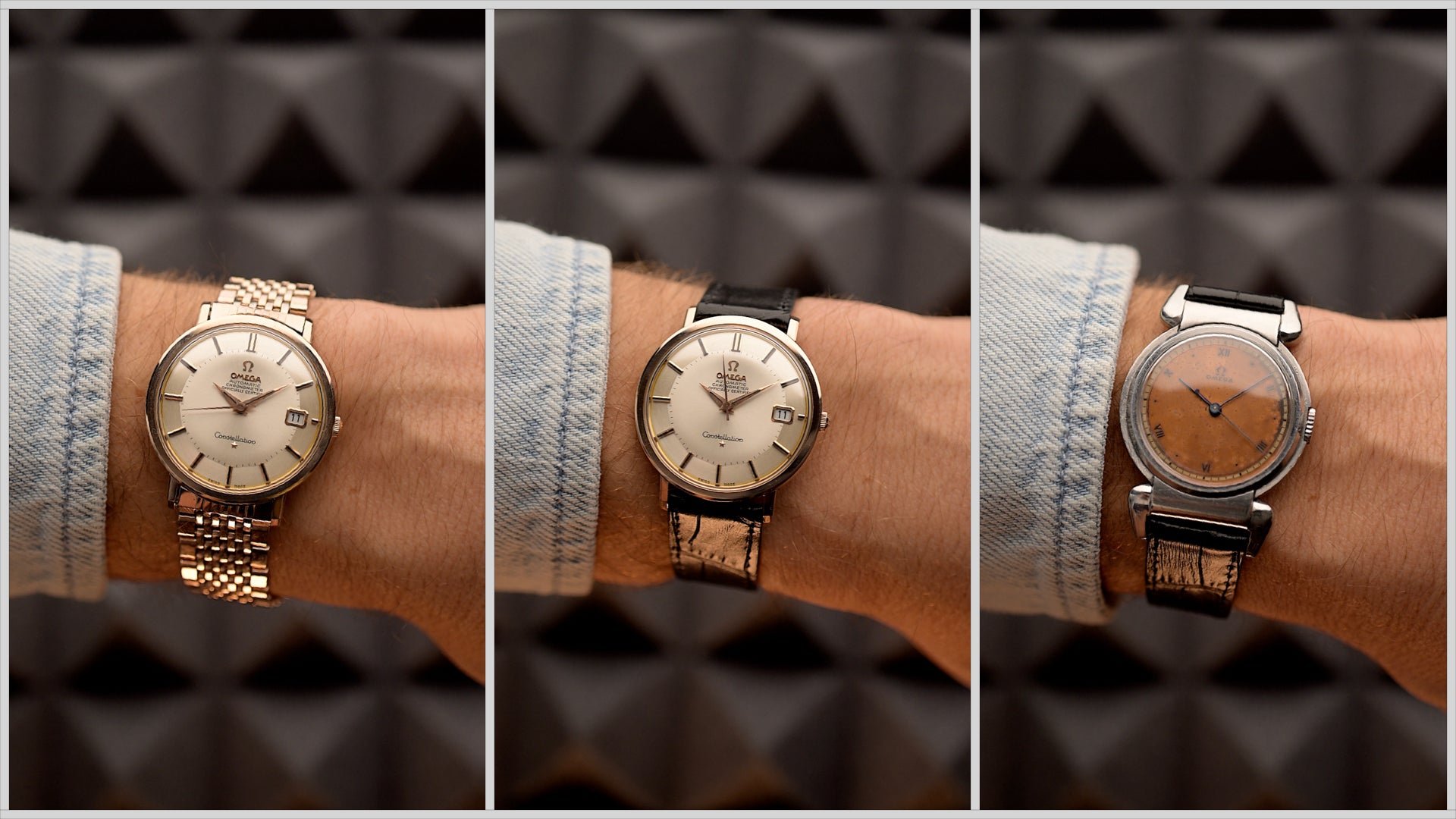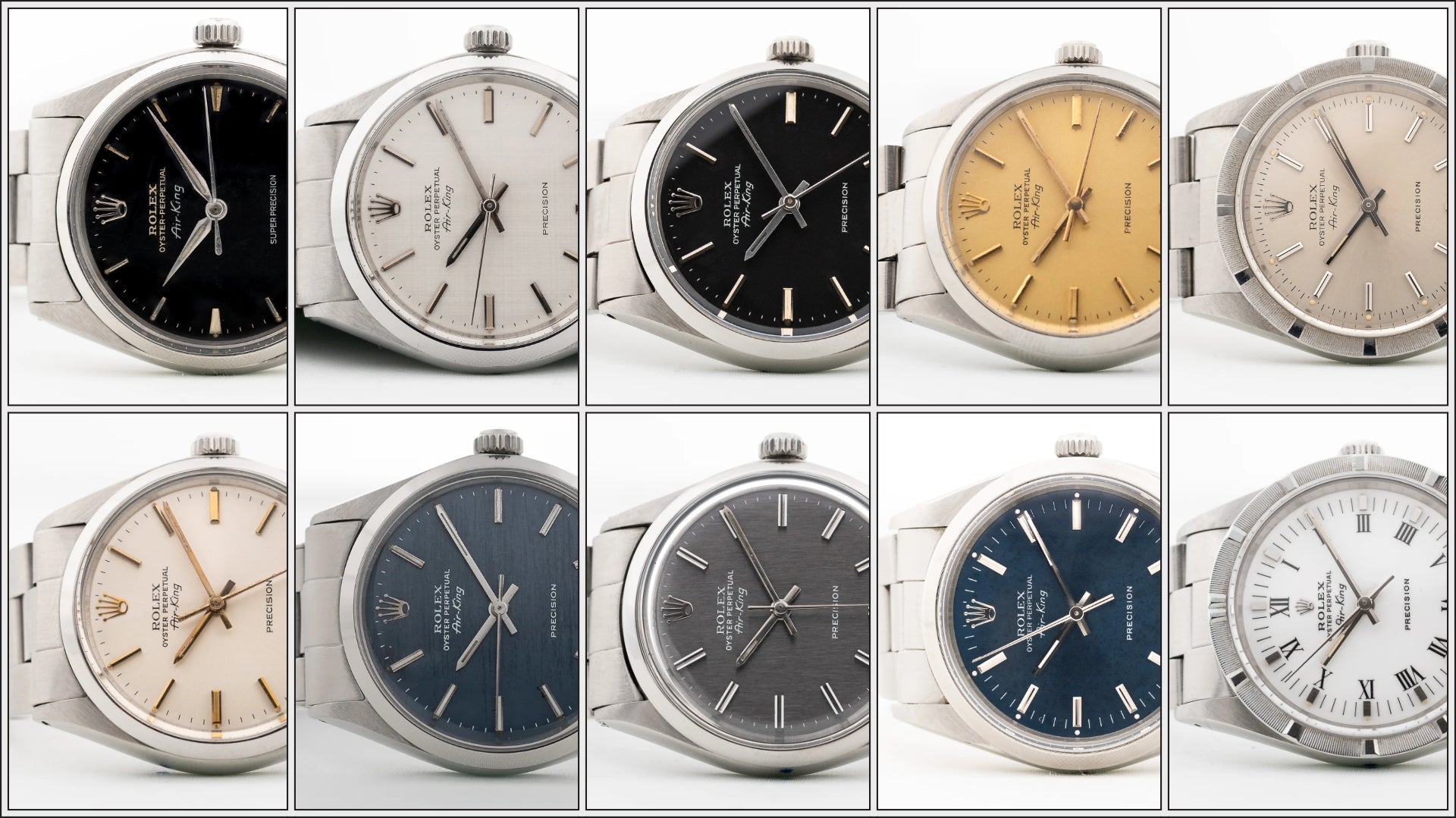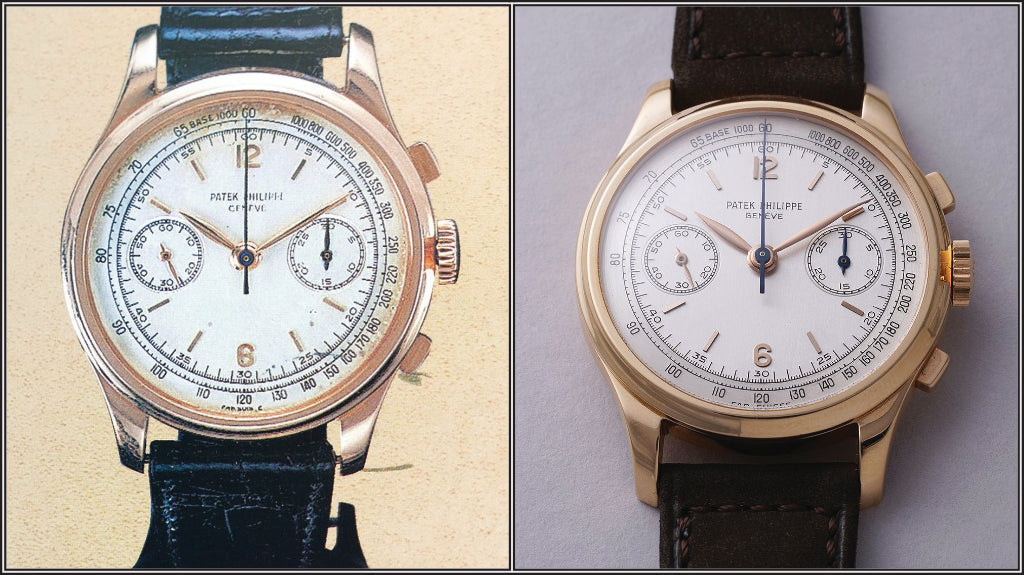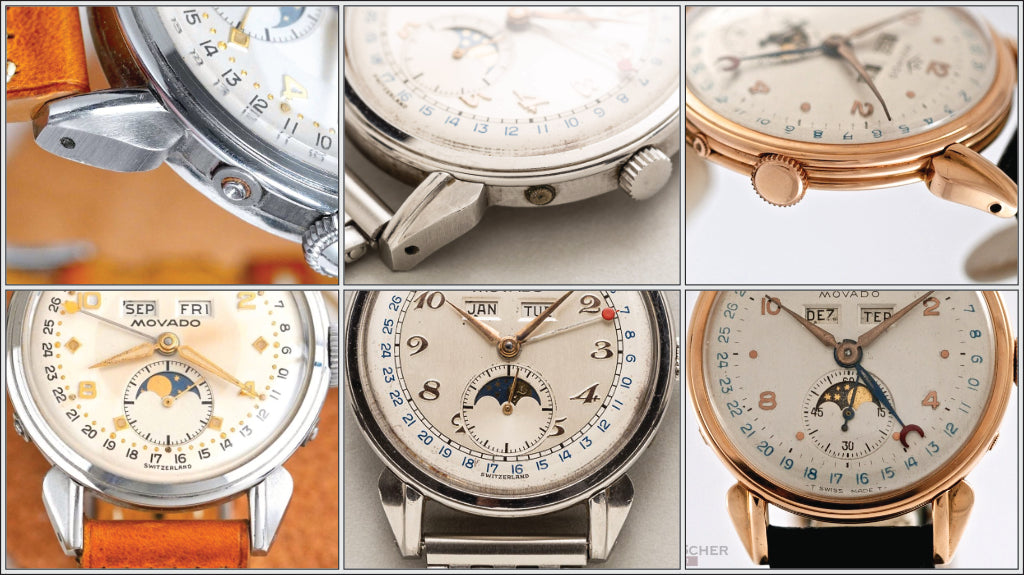February 21, 2025
More Than A Typo - The Curious Case of The Universal Geneve "Contax"

Marcus Siems @siemswatches
Collector, Author, Data Analyst
A "Contax"!? Yes, you've read correctly. This week is about the Universal Geneve Contax - the most sneakily complicated chronograph of the 1930s. You can easily mistake these mechanical wonders for the much better known "Compax" models of the time but the Contax is at its heart a completely different beast!
 Close up of a 1936 Universal Geneve Contax with black dial and flat bezel. Photo Courtesy of Carese Antique.
Close up of a 1936 Universal Geneve Contax with black dial and flat bezel. Photo Courtesy of Carese Antique.
I learned a lot about the history of these pieces from Luca Mignini (@UniversalPeopleUniversalDreams) one of the leading Universal Geneve collectors, scholar, friend and a fine gentleman (see also UG Magazine, Bonanno Interview). The here presented material is to a large extent information shared by Luca and stems from his own research on the matter.
1) Universal Geneve - Chronographs & Collections
I want to keep the intro on the different Universal Geneve chronograph watches relatively short. There are already excellent and quite exhaustive guides available*. However, what you need to know is that the modern appearance of the chronograph pretty much dates back to the 1930s. Significant innovations came hereby from Longines, Breitling, Eberhard, and - you guessed it - Universal Geneve.
Universal Geneve launched their respective chronograph movements around 1934 in the "Compur" collection: A classic two-pusher chronograph with second-, and minute stopwatch function and thus a two-register dial layout. The "Compax" (1937) came with an additional hour-counter and a three-register dial. But now to the "Contax"... made for only around one year - 1936(!) - it was actually the very first three-register chronograph. Isn't that amazing?! You may not have heard about it before but the Contax preceded the Compax!
 Evolution of the three Universal Geneve chronograph collections originating in the 1930s: The Compur (left), Contax (middle), and Compax (right). The important difference is hereby not of visual/aesthetic nature but based in their functionality... But we'll come that in a bit. Photos Courtesy of Goldammer Archives, and Kaplans.
Evolution of the three Universal Geneve chronograph collections originating in the 1930s: The Compur (left), Contax (middle), and Compax (right). The important difference is hereby not of visual/aesthetic nature but based in their functionality... But we'll come that in a bit. Photos Courtesy of Goldammer Archives, and Kaplans.
To make this even clearer. The trademark for the "Universal Watch Contax" was registered in Nov. 1935 ([Mikrolisk]) and the first Contax watches left the factory in 1936 most bearing serial numbers in the 606,xxx range and at least three known in the 587,xxx range (M.C.). Comparing this to the first Compax pieces, their serials are in the 630,xxx ([here]), 635,xxx (L.M.), & 645,xxx range ([Sala], [Christie's])***.
 Excerpt from a 1937 Universal Zenith catalogue highlighting the "Contax" as a two-pusher chronograph. "The special mechanism and the three small dials [...] allow observations up to the 12th hour, in hours, minutes, seconds, and fifths of a second". Catalogue Courtesy of Nicola (nicola1960) on orologi.forumfree.it.
Excerpt from a 1937 Universal Zenith catalogue highlighting the "Contax" as a two-pusher chronograph. "The special mechanism and the three small dials [...] allow observations up to the 12th hour, in hours, minutes, seconds, and fifths of a second". Catalogue Courtesy of Nicola (nicola1960) on orologi.forumfree.it.
2) The Mechanical Excellence
As I've mentioned before both Contax and Compax collections do not dissociate in 'look'. They share the same cases, the same dials. Further, both are second-, minute- and hour-timing chronographs and the base movements employed in both do overlap as well - the 14 ligne Martel/Universal Geneve cal. 285 (see [here], [here])**. But when you know where to look you'll notice their difference in function...
As if a two-pusher three-register chronograph wasn't special enough for the 1930s the Contax has an additional super power: When the chronograph is running, you can pull the crown and set the time. By turning the crown you will also observe that the chronograph hour-hand (at 6o'clock) will be set, too. It is hard to know what this feature was originally intended for but one possibility is using it as a long-time countdown. For example when starting your chronograph and setting the chrono-hour to 4 you'd have an 8h-countdown, which you could use to clock your day at the office for example.
 Comparing the Contax movement (bottom right, cal. 283; bottom middle, cal. 285) with a "standard" UG movement (top middle, top right and bottom left). The Contax employs an additional wheel (pink circle) to set the hour that is missing from the standard movement (dial-side view of the movement). The patent CH202179 (top left) establishes this extra functionality/complication. Note: Most Contax watches come with a cal. 285, the same applies there. Photos Courtesy of P.G. Sala (Universal Watches Geneve), Carese Antique Watches, and Clinique Horlogere.
Comparing the Contax movement (bottom right, cal. 283; bottom middle, cal. 285) with a "standard" UG movement (top middle, top right and bottom left). The Contax employs an additional wheel (pink circle) to set the hour that is missing from the standard movement (dial-side view of the movement). The patent CH202179 (top left) establishes this extra functionality/complication. Note: Most Contax watches come with a cal. 285, the same applies there. Photos Courtesy of P.G. Sala (Universal Watches Geneve), Carese Antique Watches, and Clinique Horlogere.
One might think that this is rather a bug than a feature... Maybe the first version of the three-register chronos were a little more prone to error? Further, you also don't find any descriptions of this feature in contemporary ads... It's possible but I think another theory is more likely. Let me explain:
If you turn the movement around and look at it dial-side up you'll notice a little wheel close to the center between 3 and 4o'clock (see above). That is a feature that you won't find on "standard" Compax movements. It is the little extra functionality you need for this silent complication ([source], [Sala]) and also part of the appended second chronograph patent from Martel (CH189191 & CH202179 with extra clutch-/transmission wheel). This extra component cements the chronograph-hour-setting not only as an intended complication but also a forgotten world's first for Universal Geneve.
 French 1937 Hermes advertorial featuring the "Hermes Contax" and highlighting its chronograph specific functionality. Advertorial Courtesy of Nicola (nicola1960) on orologi.forumfree.it.
French 1937 Hermes advertorial featuring the "Hermes Contax" and highlighting its chronograph specific functionality. Advertorial Courtesy of Nicola (nicola1960) on orologi.forumfree.it.
3) The Variations of the Contax
The reason you may have never heard of the "Contax" and its peculiar functionality before is because they're rare. Like rare rare. We're speaking about two dozen known examples today:
| Serial | Reference | Material | Dial | Link |
|---|---|---|---|---|
| 587,651 | / | steel | white, lume, pencil hands, Arabic 12, small sub-dials | Omega Forum |
| 587,721 | / | steel | Hermes, white, black print, no lume, leaf hands, Arabic 12, small sub-dials | Omega Forum, Drouot |
| 587,739 | / | steel | white, lume, pencil hands, Arabic 12, small sub-dials | Omega Forum |
| 603,424 | / | steel | white, black print, leaf hands, Arabic 12, short stick marker, no Tachy | / |
| 606,xxx | / | 18k YG | white | / |
| 606,2xx | / | 18k YG, 40mm | / | / |
| 606,7xx | / | 18k YG | white, black print, Arabic 12, stick marker, no Tachy | 8ball_watch |
| 607,782 | / | steel | black, gold print, double-square 12, stick marker, no Tachy | / |
| 607,784 | 3035 | steel | black, white print, arabic 12, stick marker | Antiquorum |
| 607,794 | / | steel | white, black print, Arabic 12, stick marker | / |
| 607,811 | 3035 | steel | white, black print, Breguet numerals | Kaplan |
| 607,821 | / | steel | white, no lume | / |
| 612,110 | (614) | steel | white, black print, lume, pencil hands, Arabic 12, small sub-dials | Omega Forum |
| 617,xxx | / | steel | black | / |
| 617,xxx | pocket watch | steel | black, golden print, Circular marker | Sala p.286, Omega Forum |
| 623,066 | Jaeger | steel | white, black print, Arabic numerals, small sub-dials | Omega Forum |
| 630,204 | 5126 | steel | Astrua, black, white print, Arabic 12, stick marker | Phillips, Orologi Forum |
| 630,293 | 5126 | steel | yellow, no lume | / |
| 633,211 | 5922 | 18k YG | white, black print, double-square 12, stick marker, Tachy+Tele | ClassicWatch |
| 633,219 | 5922 | 18k YG | white | / |
| 657,480 | / | steel | black, white print, double-square, stick marker | Carese |
| 657,513 | / | steel | Universal, black, gold print, Breguet numerals, Mile-Tachy (400) | Carese |
| 665,236 | 5124 | steel | white, black print, double square, stick marker | / |
| 680,xxx | (607) Cal. 283 | 18k YG | white, black print, Arabic numerals, baton hands, no Tachy | Sala p.287 |
Table 1. Overview over the known Universal Geneve Contax pieces. List includes data from Mark020 & Martin Cenek.
Overall, we can identify 24 dissociable Contax iterations listed over the last couple of years. Only 4 of them went through auction houses at some point (Antiquorum HK, Phillips Gen., Kaplan, Drouot). Another two sold through public dealers (Japan). There is one reported pocket watch and one cal. 283, the remaining 22 pieces come as a cal. 285 wrist-chronograph.
Most pieces are in steel (17) vs. 6 in yellow gold (cases made by Georges Croisier [Genevan key #5] and Henri Jeanneret [Le Locle, hammerhead #166], C8, [source]). We got slightly more white than black dials (14 to 5, respectively). Most come with a base-1000 Tachymeter scale (9), except one Mile (base-400) Tachymeter, one with red Tachy- and blue Telemeter-scale, and 4 without Tachymeter and only an outer (Breguet) seconds track. There's further at least one Jaeger Contax out there as well ([source]).
Further, some of the earliest examples (606,7xx) displayed "Patent Pending" (Brevet Demandé) inside the case back (C8). We can thus explicitly date them to the time-frame between February 13th 1936 and February 15th 1937 (CH189191). According to estimations the overall production may between 400-800 Contax ever made ([source]).
 Three example Contax models. Photos Courtesy of Antiquorum, Kaplan, & Cristophe (@8ball_watches).
Three example Contax models. Photos Courtesy of Antiquorum, Kaplan, & Cristophe (@8ball_watches).
It might also be said that potentially some of these 22 may have been recased at some point. With unknown ground truth about the production period and serial range the most outside numbers are the hardest to substantiate. On the lower end, two display a caseback bearing the serial 587,xxx, which appears to be too early. However, since there are at least two in this range by now they might very well be genuinely the earliest serial range. On the upper end, two other are marked 657,xxx and at least one 665,xxx ranking well within the "Compax" range and might be later recased examples (according to L.M.). The mechanism (transmission wheel) however is visible in all of these pieces making them true Contax watches.
 One of the most stunning Contax pieces out there - a "Universal"-only signed piece with black dial, gold printing, Breguet numerals and golden leaf hands. Photos Courtesy of Carese Antique Watches.
One of the most stunning Contax pieces out there - a "Universal"-only signed piece with black dial, gold printing, Breguet numerals and golden leaf hands. Photos Courtesy of Carese Antique Watches.
4) The Conclusion
After all is said and done there's only one question left to answer: Why didn't they last? Why was the production range so short? One leading hypothesis is that going the extra mile and including the silent complication (chrono-hour-hand setting) was simply too complicated and thus too expensive for the Contax to become a profitable member of the UG catalogue.
 An oversized shop display of the Universal Geneve Contax from the late 1930s. Photo Courtesy of Christophe (@8ball_watch).
An oversized shop display of the Universal Geneve Contax from the late 1930s. Photo Courtesy of Christophe (@8ball_watch).
But then why would you even add it in the first place? It's not advertised in the contemporary ads as a unique selling point (see above), which it definitely would have been. It's also the first known hour-counter so patent issues shouldn't arise either. Maybe it's that the use-case for the complication wasn't really clear... I mean we're still trying to find out what to do with. It's so subtle that even UG-super collector Pietro Giuliano Sala didn't know these pieces could do the trick until one was opened up ([Sala]).
 A 1937 Universal Geneve advertisement in the Swiss "International Review of Watchmaking" magazine (Revue Internationale de l'Horlogerle et des branches annexes, Neuchatel, 1900-60, [source]) for their latest creations including the "hour meter" chronograph (Compteur D'Heures) with its patent (Note: there's a typo in the patent, it should actually read 189191). The text (not shown) speaks about UG's participation in the Basel Fair and their focus on chronograph novelties, explicating the "hour meter" and its merit for aviators and motorists. Advertorial Courtesy of Nicola (nicola1960) on orologi.forumfree.it.
A 1937 Universal Geneve advertisement in the Swiss "International Review of Watchmaking" magazine (Revue Internationale de l'Horlogerle et des branches annexes, Neuchatel, 1900-60, [source]) for their latest creations including the "hour meter" chronograph (Compteur D'Heures) with its patent (Note: there's a typo in the patent, it should actually read 189191). The text (not shown) speaks about UG's participation in the Basel Fair and their focus on chronograph novelties, explicating the "hour meter" and its merit for aviators and motorists. Advertorial Courtesy of Nicola (nicola1960) on orologi.forumfree.it.
Whatever the reason may have been, the Contax was discontinued before it could ever really take off. However, this doesn't take away its historical significance. We should not mistake the Contax for a footnote simply because of its prototype-esque run. These pieces do not only share the classic Universal Geneve 1930s/40s design language but - more importantly - are actually the very first three-register chronographs of the Genevan power house.
And even more. Think about it, the first Contax pieces were made in 1936. Other Chronograph movements including an hour-counter came from Valjoux (V72) in 1938, Omega's CH27 in 1942, same year as Venus' cal. 178 ([source],[source])... (to the best of my knowledge) This makes the Contax the very first chronograph with hour-counter - as in ever(!), worldwide ([source], [source]). The face of the modern chronograph was born with the Contax! I'm flabbergasted.
Let that sink in... it's not just an important chronograph. With the Contax you got yourself one of the most important all-around watches(!) of all time.
Acknowledgements
As I've disclaimed in the beginning, this is a passion project in collaboration with Luca Mignini (@UniversalPeopleUniversalDreams). This article would lack a lot of the insights if it wouldn't have been for him. Imagine this work as a menu, then Luca's the chef and I'm adding a little seasoning and some thyme.
Since it is always tough to cite forum posts properly I'd like to extend my thanks to two of the great forum scholars in the Universal Geneve field: Nicola (nicola1960), Martin Cenek (martinc) and Mark A. (Mark020) are on the record unearthing the enigma of the Contax (and many other UG chronographs) over last 15 years. Furthermore, I want to thank the collectors Christophe (@8ball_watch) and @Jumpingsecond for their valuable insights and visual aid.
Footnote
* For example the book "Universal Watch Geneve" by P.G. Sala [Link], and Mr.A's Universal Geneve infopage [Link] as well as the revived and forming official Universal Geneve webpage [Llink].
** That is, the very first executions are cal. 285. Several other Martel/UG chronograph calibers were employed during the 1930s but not in the very first hour-counter chronographs.
*** An Hermes signed 18k yellow gold "Compax" has been sold most recently through Sotheby's with the serial 630,122. If indeed the Contax mechanism is missing, this would make it the oldest known 3-register Compax.
All rights on text and graphics reserved to the Author.




























1 comment
Pure gold. Thank you very much Marcus. I’m not clear though on the question of how the Contax ‘first’ stands in relation to the Moinet chronograph of 1816. Can you enlighten me? Thanks.
Leave a comment